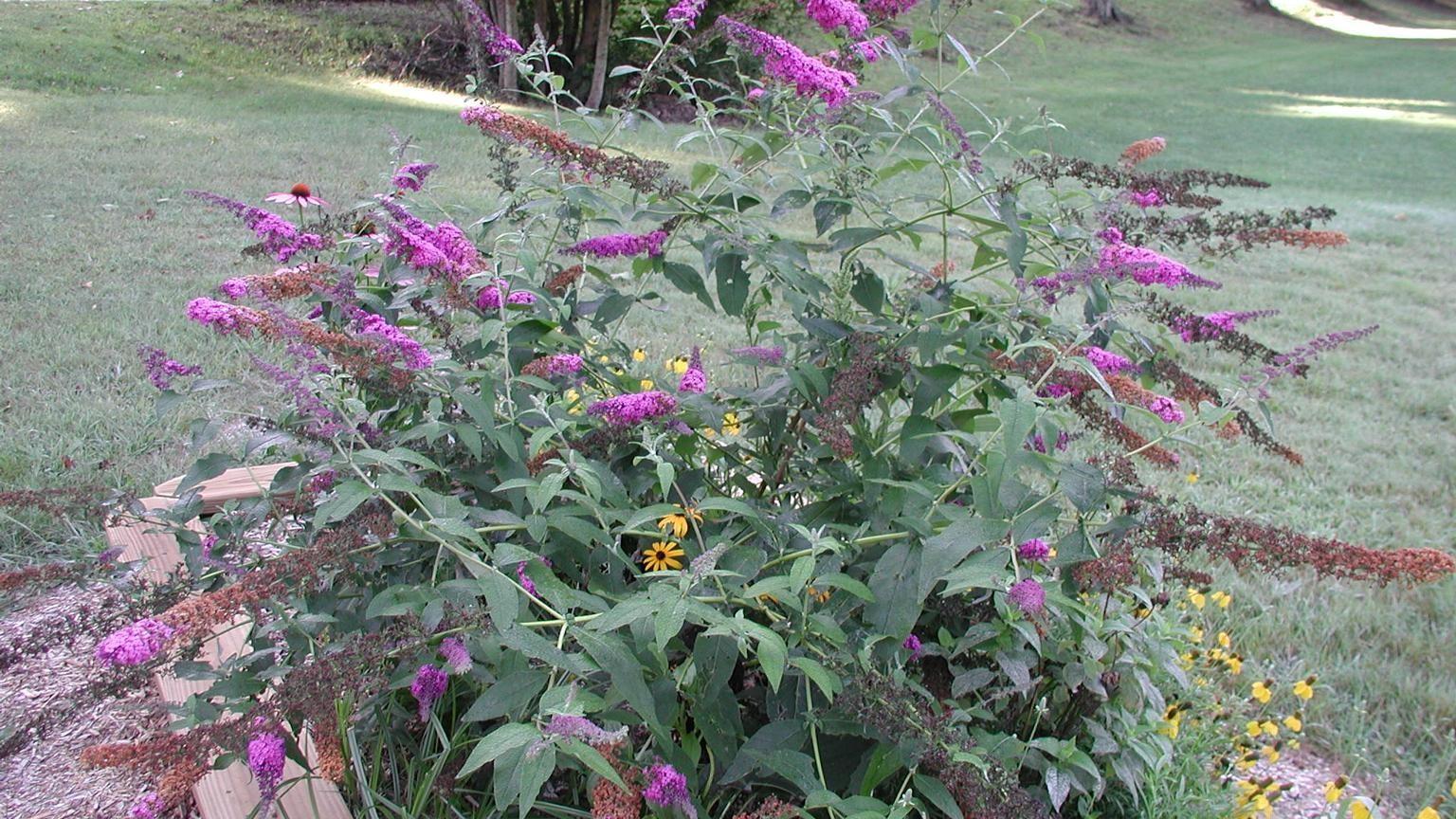About butterfly bush (Buddleja davidii)
Life cycle/information: Butterfly bush, also called summer lilac, is a deciduous shrub bearing wands of purple, pink, or white flowers at the branch tips from summer to fall. Introduced from Asia around 1900, butterfly bush has escaped cultivated plantings and is found in wild areas of at least 20 states. It crowds out native plants that would provide essential food for butterflies, birds, and other wildlife.
Growth habit: Fast-growing and invasive. This woody shrub grows 3-15’ tall in a single season. Leaves are opposite, pale-gray, with toothed or wavy margins. Flowers are grouped in a cluster at the branch tips and bloom from mid-summer to fall. Flowers can be purple, pink, lilac, or white, with yellow to orange centers. Abundant nectar is attractive to adult butterflies, but no native North American butterfly caterpillars can use butterfly bush as a host plant food source. Without host plants for caterpillars, butterflies cannot survive.
Invasive Plants to Avoid Buying for your Yard and Garden in Maryland

Photo: Leslie J. Mehrhoff, University of Connecticut, Bugwood.org
Reproduction: Each flower produces a capsule containing many small seeds. Seeds are dispersed by wind and water. Butterfly bushes do not spread vegetatively.
Conditions that favor growth: Establishes in sunny, dry, disturbed sites with well-drained soils. It also colonizes riparian areas such as stream and river banks.

Photo: Leslie J. Mehrhoff, University of Connecticut, Bugwood.org
What to plant instead: New York Ironweed (Vernonia noveboracensis), New England Aster (Symphyotrichum novae-angliae), Sweet Pepperbush (Clethra alnifolia), Virginia Sweetspire (Itea virginica), Butterfly Weed (Asclepias tuberosa), Blazing Star (Liatris spicata)
Controlling butterfly bush
Dig out plants. Remove spent flowers before they set seeds.
Additional resources and references
Kaufman, Sylvan Ramsey & Wallace Kaufman. 2007. Invasive Plants: Guide to Identification and the Impacts and Control of Common North American Species.
Swearingen J., K. Reshetiloff, B. Slattery, and S. Zwicker. 2002. Plant Invaders of Mid-Atlantic Natural Areas. National Park Service and U.S. Fish & Wildlife Service, Washington, DC.
Tallamy, Douglas W. 2007. Bringing Nature Home: How Native Plants Sustain Wildlife in Our Gardens, Timber Press.
Compiled by Christa Carignan, reviewed by Debra Ricigliano, University of Maryland Extension, 5/2018
Still have a question? Contact us at Ask Extension.
 English
English العربية
العربية Български
Български 简体中文
简体中文 繁體中文
繁體中文 Hrvatski
Hrvatski Čeština
Čeština Dansk
Dansk Nederlands
Nederlands Suomi
Suomi Français
Français Deutsch
Deutsch Ελληνικά
Ελληνικά हिन्दी
हिन्दी Italiano
Italiano 日本語
日本語 한국어
한국어 Norsk bokmål
Norsk bokmål Polski
Polski Português
Português Română
Română Русский
Русский Español
Español Svenska
Svenska Català
Català Filipino
Filipino עִבְרִית
עִבְרִית Bahasa Indonesia
Bahasa Indonesia Latviešu valoda
Latviešu valoda Lietuvių kalba
Lietuvių kalba Српски језик
Српски језик Slovenčina
Slovenčina Slovenščina
Slovenščina Українська
Українська Tiếng Việt
Tiếng Việt Shqip
Shqip Eesti
Eesti Galego
Galego Magyar
Magyar Maltese
Maltese ไทย
ไทย Türkçe
Türkçe فارسی
فارسی Afrikaans
Afrikaans Bahasa Melayu
Bahasa Melayu Kiswahili
Kiswahili Gaeilge
Gaeilge Cymraeg
Cymraeg Беларуская мова
Беларуская мова Íslenska
Íslenska Македонски јазик
Македонски јазик יידיש
יידיש Հայերեն
Հայերեն Azərbaycan dili
Azərbaycan dili Euskara
Euskara ქართული
ქართული Kreyol ayisyen
Kreyol ayisyen اردو
اردو বাংলা
বাংলা Bosanski
Bosanski Cebuano
Cebuano Esperanto
Esperanto ગુજરાતી
ગુજરાતી Harshen Hausa
Harshen Hausa Hmong
Hmong Igbo
Igbo Basa Jawa
Basa Jawa ಕನ್ನಡ
ಕನ್ನಡ ភាសាខ្មែរ
ភាសាខ្មែរ ພາສາລາວ
ພາສາລາວ Latin
Latin Te Reo Māori
Te Reo Māori मराठी
मराठी Монгол
Монгол नेपाली
नेपाली ਪੰਜਾਬੀ
ਪੰਜਾਬੀ Afsoomaali
Afsoomaali தமிழ்
தமிழ் తెలుగు
తెలుగు Yorùbá
Yorùbá Zulu
Zulu ဗမာစာ
ဗမာစာ Chichewa
Chichewa Қазақ тілі
Қазақ тілі Malagasy
Malagasy മലയാളം
മലയാളം සිංහල
සිංහල Sesotho
Sesotho Basa Sunda
Basa Sunda Тоҷикӣ
Тоҷикӣ O‘zbekcha
O‘zbekcha አማርኛ
አማርኛ Corsu
Corsu Ōlelo Hawaiʻi
Ōlelo Hawaiʻi كوردی
كوردی Кыргызча
Кыргызча Lëtzebuergesch
Lëtzebuergesch پښتو
پښتو Samoan
Samoan Gàidhlig
Gàidhlig Shona
Shona سنڌي
سنڌي Frysk
Frysk isiXhosa
isiXhosa